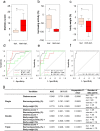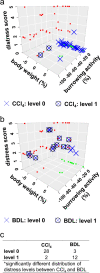Comparing distress of mouse models for liver damage
- PMID: 33188220
- PMCID: PMC7666197
- DOI: 10.1038/s41598-020-76391-w
Comparing distress of mouse models for liver damage
Abstract
In order to foster animal welfare as well as high quality of research, many countries regulate by law that the severity of animal experiments must be evaluated and considered when performing biomedical research. It is well accepted that multiple parameters rather than a single readout parameter should be applied to describe animal distress or suffering. However, since the performance of readout parameters for animal distress is rarely defined and methods for multivariate analysis have only in rare cases been used, it is not known which methodology is most appropriate to define animal distress. This study used receiver operating characteristic curve analysis to quantify the performance of burrowing activity, body weight change and a distress score of mice after induction of liver damage by bile duct ligation or carbon tetrachloride. In addition, Support Vector Machine classification was used to compare the distress of these mouse models. This approach demonstrated that bile duct ligation causes much more distress than carbon tetrachloride-induced liver damage. This study, therefore, provides a prototype how to compare two animal models by considering several readout parameters. In the future these or similar methods for multivariate analysis will be necessary, when assessing and comparing the severity of animal models.
Conflict of interest statement
The authors declare no competing interests.
Figures






References
-
- 1National Research Council (US) Committee for the Update of the Guide for the Care and Use of Laboratory Animals. Guide for the Care and Use of Laboratory Animals (Eighth Edition). (National Academy of Sciences, 2011).
-
- 2Directive 2010/63/EU of the European Parliament and of the Council of 22 September 2010 on the protection of animals used for scientific purposes (Text with EEA relevance). Available from: https://eur-lex.europa.eu/LexUriServ/LexUriServ.do?uri=OJ:L:2010:276:003.... (2019).
Publication types
MeSH terms
Substances
LinkOut - more resources
Full Text Sources
Medical

